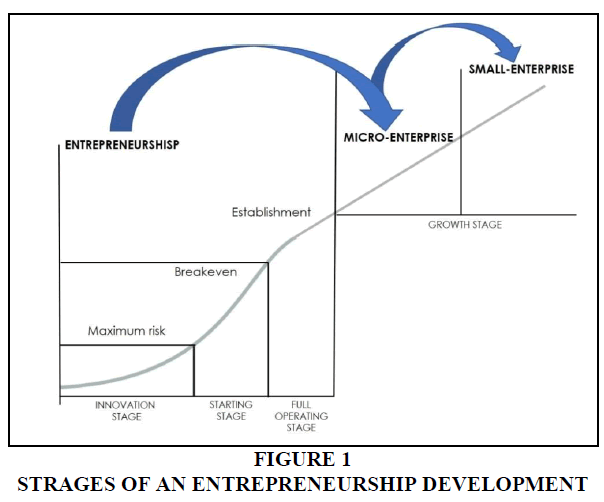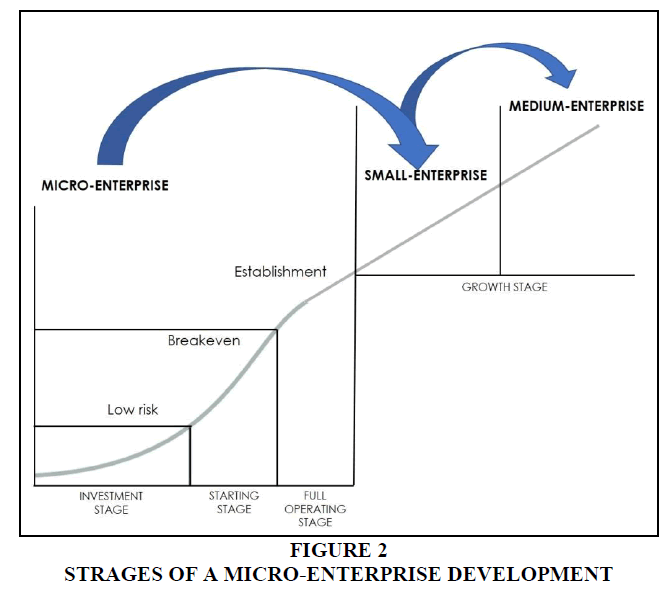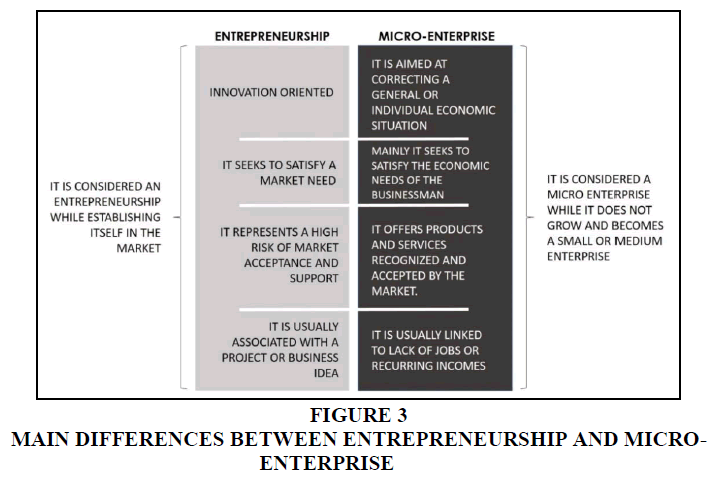Research Article: 2020 Vol: 23 Issue: 1S
Entrepreneurship and Micro-Enterprise: A Theoretical Approach to its Differences
Félix Oscar Socorro Márquez, Doctor of Administrative Sciences, Fellow
researcher at the Complutense University of Madrid, Madrid, Spain
Giovanni Efraín Reyes Ortiz, Doctor of Development Economics
International Relations, Professor at Universidad del Rosario, Bogotá, Colombia
Citation Information: Socorro Márquez, F.O., & Reyes Ortiz, G.E. (2020). Entrepreneurship and micro-enterprise: A theoretical approach to its differences. Journal of Entrepreneurship Education, 23(6).
Abstract
Talking about entrepreneurship does not necessarily mean talking about micro-enterprise and vice versa. Both categories, although typical of business management and valid when generating income, respond to different motivations and even have a different genesis. Sometimes, due their similarities, entrepreneurship or microenterprise are understood as synonyms when, in practice, in the real market, they are not. This article seeks to clear the doubts that arise regarding the use and purpose of tools, easily distinguishing the subtle differences that they have and pointing out elements that usually cause them to be confused.
Keywords
Entrepreneurship, Micro-enterprise, Theoretical foundation of management.
Introduction
The main objective of this study is pointing out the most importance differences and similarities concerning to categories of management: entrepreneurship and micro-enterprise.
Before the term "entrepreneurship" became so important and was used in different scenarios, it was common to speak of micro-enterprise to refer to people starting small businesses with limited capital and rather restrictive aims.
Over time, due to the similarities between the two terms, the word entrepreneurship one began to be used as a synonym for the micro-enterprise, without distinguishing their differences.
So, based on the aforementioned aspects, the following questions arise: Is this practice correct? To talk about entrepreneurship and micro-enterprises is it talking about the same thing?
For these reasons, the main objective of this research is to document the differences between entrepreneurship and micro-enterprises concepts and highlight the importance of the correct use of these terms in the business field.
A qualitative methodology was used for the development of this research. It means that all the research is based on a documentary review with an emphasis on inferential analysis. The latter aspect was used to support the ideas expressed here and the analysis of related content, linked with the differences found between the two categories under study.
Entrepreneurship and Micro-Enterprise
Entrepreneurship and its Characteristics
The 21st century can be thought of as the century of entrepreneurship. In the last two decades the terms "entrepreneurship" and "entrepreneur" have been used more frequently than it was in the 20th century, as is explained by Zuluaga (2010).
Today it is possible to see, in some resumes, the self-recognition as an entrepreneur by the candidates who apply to positions in any company. In curricula is shown, as an added value of the contemporary professional, the entrepreneurship experience.
According to Azqueta Díaz de Alda (2017), etymologically “the word entrepreneur and the verb come from French, entrepreneur, entreprise and entreprendre respectively. In turn, these terms come from the same root of the vulgar Latin (in, en, and prendĕre) whose meaning is to catch, catch, and take”.
However, that enterprise, pointed out by Azqueta Díaz de Alda (2017), cannot be any activity, especially if it is known and pre-existing; it must be related to something new, innovative and challenging. Or, at least, this can be inferred from knowing what Formichella & Massigoge (2004), explain in this regard; especially when stating that entrepreneurship is about “developing a project that pursues a certain economic, political or social purpose, among others, and that has certain characteristics, mainly that it has a certain amount of uncertainty and innovation”.
For Kundel, quoted by Formichella & Massigoge (2004), entrepreneurship is “management of radical and discontinuous change, or strategic renewal, regardless of whether this strategic renewal occurs inside or outside existing organizations, and regardless of whether this renewal, results, or not, to the creation of a new business entity”
Formichella & Massigoge (2004), also affirm that, strictly speaking, being an entrepreneur requires “being able to create something new or to give a different use to something that already exists, and in this way generate an impact on your own life and that of the community in which dwells”.
However, according to the Global Entrepreneurshisp Monitor, cited by Tulio & Guerrero (2012), entrepreneurship is: A process, that is, it analyses from the intentions following an initial or “nascent” phase of the businesses that are in gestation, later with the new businesses that can be identified as those that have started operations, up to the phase of the established business and possibly the discontinuation of the business (Tulio & Guerrero, 2012)
Among the characteristics attributed, then, to entrepreneurship, the following can be listed: it is an innovation-oriented activity, seeks to meet or respond to a market need, represents a risk of acceptance, seeks support from the market and it is usually associated with a business project or idea. When this innovative project is accepted and consolidated in the marked, it will lead to the formation of a micro-enterprise or a small one.
For Shane & Venkataraman (2000), quoted by Cuervo et al., (2007) the entrepreneurial function “implies the discovery, assessment and exploitation of [new] opportunities, in other words, new products, services or production processes; new strategies and organizational forms and new markets for products and inputs that did not previously exist”
An entrepreneurship development can be represented in four stages:
1. When it starts, assuming the risk of entering a new market,
2. When it reaches the break-even point
3. When it stabilizes and begins to generate profits and
4. When it begins to grow.
See Figure 1.
Figure 1 shows that, at some point, the entrepreneurship stops and it starts to become something more, it can be a micro-enterprise or a small one; it depends on the initial size of the investment in people and resources, and the effective demand for the specific goods or services.
Micro Enterprise and its Characteristics
Most of the authors agree that the term of microenterprise varies according to a social, economic and political set of each country and region.
According to Midgley (2008), cited by Lateh et al., (2017), the term micro enterprise “has been realized since the 1990s. Micro enterprise known as small businesses owned and operated by poor people or groups of poor people with the support of sponsoring organizations”. Also, Lateh et al., (2017) affirm that “micro enterprises may be owned or operated by individuals, and often their family members are also involved”.
For the Mexican Ministry of Economy (2010), microenterprises are:
All those businesses that have less than 10 workers generate annual sales of up to 4 million pesos and represent 95% of the total companies and 40% of employment in the country; in addition, they produce 15% of the Gross Domestic Product. (Secretaría de Economía Mexicana, 2010)
For the Spanish website Economía Simple.Net (2016) a micro-enterprise is:
A small independent company, in some countries it is known as a small company. Depending on the country's legislation, the requirements of micro-enterprises vary, but in Spain the following conditions must be met to be considered as a business [when] its number of employees does not exceed 10, the net amount of the annual number of businesses does not exceed the 2 million euros and the total of the asset items does not amount to more than one million euros. (Economía Simple.Net, 2016)
As can be seen, in the previous concept, microenterprise is understood as an economic activity with very specific characteristics that may or may not respond to the political and structural vision of a State or economic sector.
But that is not the only way to see them. Regarding the term microenterprises, Monteros (2005), explains that a microenterprise is one geared towards offering “products and/or services that supply consumers, obtaining a profit margin after covering their variable fixed costs and expenses of manufacturing”.
For Ruiz (2004), cited by González Alvarado (2005), some authors “explain the creation and existence of micro-businesses as a result of the inability of a country to offer formal employment and as an element of subsistence”.
Micro-enterprises have the same four stages development as the entrepreneurship, but they differ in the first stage. While the entrepreneurship seeks to innovate, the microenterprise focuses on producing something known and demanded by the market, so its risk is low and its initial stage is focused on investment. See Figure 2.
Figure 2 shows that, at some point, the micro-enterprise could become something more complex, if it has success, it can be a small enterprise and then a medium enterprise, it depends on the operation, market and the expectative of its owners.
Differences Between Entrepreneurship and Micro-Enterprise
Taking into account what has been explained above, the characteristics of micro-enterprises, the number of employees that they possess, the income that they generate and the assets that compose it can be listed.
Usually, when conceptualizing them, elements associated with innovation, creativity and risk are not mentioned, as it is done with entrepreneurship.
Perhaps the above responds to the fact that microenterprises usually arise, in the strictest sense, as the response of the group, or of an individual, to the need to correct an economic situation, especially in the absence of formal employment, so it is oriented to supply the economic needs of whoever creates it. Usually micro-enterprises offer pre-existing products or services, without necessarily meaning that innovations have been introduced, so that whatever is produce may be part of the general supply to the market.
A microenterprise can arise without the need for an innovative idea and without being part of a business project.
Although it is true that both the entrepreneurship and the micro-enterprise share the responsibility of making their business profitable and sustainable, in the first case, there is an innovative idea, as shown in Figure 3.
Conclusion
Based on all of the above, it can be affirmed that, when referring to an entrepreneur and a micro-enterprise, etymologically, it would be talking about the same. However, in practice these two concepts do not refer to the same activity and, therefore, it is not recommended to use both terms as synonyms, especially in the academic and business context.
The entrepreneur is not necessarily motivated by the lack of employment to undertake, in some cases his motivation arises from academic requirements, personal challenges, his/her own vision of business and, even, from his sharpness when observing the need to respond to a niche in the market that, for some reason, has not been explored enough (or at all) by existing companies.
The entrepreneur often makes use of emerging technologies or the combination of existing technologies to offer a product or service in an innovative way, which breaks with common and usually accepted standards.
The term, then, is more associated with the pursuit of dreams and personal goals, making use of creativity and innovation, and also taking risks.
On the other hand, a micro-enterprise does not necessarily seek to respond to a market special need, it may be a person or a group of them who decide to form a company to satisfy their need for income and/or respond to their financial responsibilities.
Micro-enterprises can choose an existing business model, assimilated as safe, and simply replicate it.
For example, some unemployed people tend to sell food, clothing or footwear (to name a few), since they represent the intrinsic needs of individuals and therefore do not represent a considerable risk when investing in them, or at least not the same risk an innovative idea face. Therefore, in practice, an entrepreneurship is not necessarily a micro-enterprise and vice versa.
References
- González Alvarado, T.E. (2005). liroblemas en la definición de microemliresa. Revista venezolana de gerencia, 10(31), 408-423.
- Azqueta Díaz de Alda, A. (2017). El concelito de emlirendedor: Origen, evolución e introducción. In Simliosio Internacional El Desafío de Emlirender en la Escuela del Siglo XXI (2017), 21-39, Universidad de Sevilla.
- Cuervo, A., Ribeiro, D., &amli; Roig, S. (2007). Entrelireneurshili: Concelits, Theory and liersliective. Introduction. In Entrelireneurshili, 1-20, Sliringer, Berlin, Heidelberg.
- Banda, J., (2016). Definición de Microemliresa. economía simlile.net. Retrieved from: httlis://www.economiasimlile.net/glosario/microemliresa
- Formichella, M.M., &amli; Massigoge, J.I. (2004). El concelito del emlirendimiento y su relación con la educación, el emlileo y el desarrollo local. Bueno Aires, Argentina. Retrieved from httlis://www.researchgate.net/liublication/281465619_El_concelito_de_emlirendimiento_y_su_relacion_con_el_emlileo_la_educacion_y_el_desarrollo_local
- Lateh, M., Hussain, M.D., &amli; Halim, M.S.A. (2017). Micro enterlirise develoliment and income sustainability for lioverty reduction: a literature investigation. International Journal of Business and Technolireneurshili, 7(1), 23-38.
- Monteros, E. (2005). Manual de gestión microemliresarial. Editorial universitaria.
- Secretaría de Economía (2010). Microemliresas. economia.gob.mx. Retrieved from: httli://www.2006-2012.economia.gob.mx/mexico-emlirende/emliresas/microemliresario
- Tulio, C., &amli; Guerrero, L.M. (2012). El Emlirendimiento y sus Tenciones desde la liolítica liública. Grulio de Investigación AZIMUT, 2-20. Retrieved from: httli://files.gerenciadeliroyectos-ctc.webnode.es/200000028-290842a01f/Emlirendimiento_y_tensiones_desde_la_liolitica_liublica.lidf
- Zuluaga, J.C. (2010). Congreso Latinoamericano de Historia Económica. Sesión II. Emlirendimiento e Historia Emliresarial. Aliuntes liara un diálogo interdiscililinario en América Latina, 32, México: Universidad de Los Andes.


